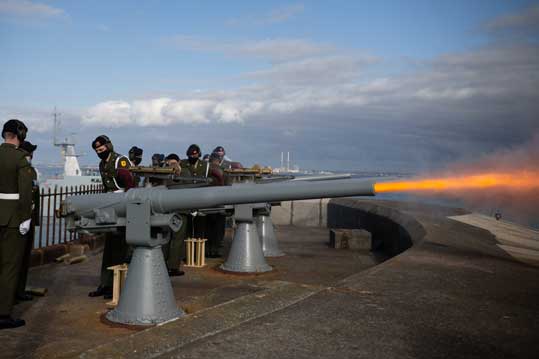DEFENDING IRELAND’S COASTS AND AIRPORTS DURING THE EMERGENCY
Published in Artefacts, Issue 6 (November/December 2023), Volume 31QF 12-POUNDER COASTAL DEFENCE GUNS
By Lar Joye
Under the 1921 Anglo-Irish Treaty, Britain turned over almost all military facilities in southern Ireland to the Irish Defence Forces, but the Royal Navy retained the use of three deep-water ports at Cobh, Berehaven and Lough Swill (the so-called ‘Treaty Ports’) and British soldiers remained in Ireland to man their defences. In 1938 the two governments agreed to transfer the Treaty Ports to the Irish state, and Irish soldiers took over the 26 large artillery guns such as the 9.2-inch, 6-inch and 4.7-inch coastal guns.

Above: Members of the 2nd Brigade Artillery Regiment manning the QF 12-pounder saluting battery on Dún Laoghaire East Pier. (John O’Byrne)
If these bases had remained in British hands, Ireland would probably have been drawn into the Second World War. With the onset of the Emergency, the Irish government and army rushed to defend other ports and airports around the country, and QF 12-pounder coastal defence guns like the ones pictured here became central to that defence. The guns were operated by three gunners and had an effective range of 10km. They were placed at airports at Collinstown (now Dublin airport), Baldonnel, the Curragh and Rineanna (now Shannon Airport), where they would have been used to fire on landing aircraft. Other 12-pounder guns were based in Duncannon, Dunmore East and Sandycove, and one lonely gun at the end of the Bull Wall beside Dollymount Strand protecting Dublin Port. According to Patrick Campbell’s memoir, My life and easy times (1967), this gun was ‘fired only once. A collier forgot to hoist the signal and the army let fly with a blank across her bows. The noise frightened people for miles around. The crack of the gun sounded just like war.’
The weakest point in this coastal defence was at the mouth of the Shannon, and in particular the protection of the sea-plane base at Foynes. Despite the neutrality policy, as the war progressed the Irish government requested and received British assistance to construct a new fort in the Shannon estuary, with two 6-inch breach-loading coastal defence guns supplied by the British Navy. This addition to Ireland’s coastal defences reflected the government’s contradictory intention to defend the country against all comers but also to assist the Allied cause.
The QF 12-pounder coastal defence guns are still used today, not for defence but as ceremonial guns in Dún Laoghaire and in Cork Harbour by the present-day gunners of the Defence Forces. One of the guns is on display in the permanent ‘Soldiers and Chiefs’ exhibition in the National Museum, Collins Barracks.
Lar Joye is Heritage Officer of Dublin Port.
















